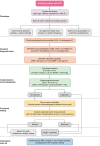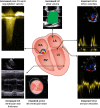Left ventricular dysfunction with preserved ejection fraction: the most common left ventricular disorder in chronic kidney disease patients
- PMID: 36381379
- PMCID: PMC9664574
- DOI: 10.1093/ckj/sfac146
Left ventricular dysfunction with preserved ejection fraction: the most common left ventricular disorder in chronic kidney disease patients
Abstract
Chronic kidney disease (CKD) is a risk factor for premature cardiovascular disease. As kidney function declines, the presence of left ventricular abnormalities increases such that by the time kidney replacement therapy is required with dialysis or kidney transplantation, more than two-thirds of patients have left ventricular hypertrophy. Historically, much research in nephrology has focussed on the structural and functional aspects of cardiac disease in CKD, particularly using echocardiography to describe these abnormalities. There is a need to translate knowledge around these imaging findings to clinical outcomes such as unplanned hospital admission with heart failure and premature cardiovascular death. Left ventricular hypertrophy and cardiac fibrosis, which are common in CKD, predispose to the clinical syndrome of heart failure with preserved left ventricular ejection fraction (HFpEF). There is a bidirectional relationship between CKD and HFpEF, whereby CKD is a risk factor for HFpEF and CKD impacts outcomes for patients with HFpEF. There have been major improvements in outcomes for patients with heart failure and reduced left ventricular ejection fraction as a result of several large randomized controlled trials. Finding therapy for HFpEF has been more elusive, although recent data suggest that sodium-glucose cotransporter 2 inhibition offers a novel evidence-based class of therapy that improves outcomes in HFpEF. These observations have emerged as this class of drugs has also become the standard of care for many patients with proteinuric CKD, suggesting that there is now hope for addressing the combination of HFpEF and CKD in parallel. In this review we summarize the epidemiology, pathophysiology, diagnostic strategies and treatment of HFpEF with a focus on patients with CKD.
Keywords: cardiovascular; chronic kidney disease; heart failure; mineralocorticoid receptor antagonism; sodium-glucose cotransporter 2.
© The Author(s) 2022. Published by Oxford University Press on behalf of the ERA.
Figures


References
-
- Gansevoort RT, Correa-Rotter R, Hemmelgarn BRet al. . Chronic kidney disease and cardiovascular risk: epidemiology, mechanisms, and prevention. Lancet 2013; 382: 339–352 - PubMed
-
- House AA, Wanner C, Sarnak Met al. . Heart failure in chronic kidney disease: conclusions from a Kidney Disease: Improving Global Outcomes (KDIGO) Controversies Conference. Kidney Int 2019; 95: 1304–1317 - PubMed
Publication types
Grants and funding
LinkOut - more resources
Full Text Sources
Research Materials

